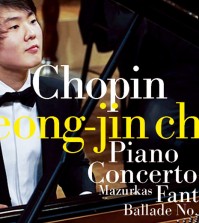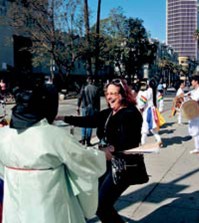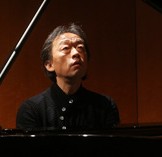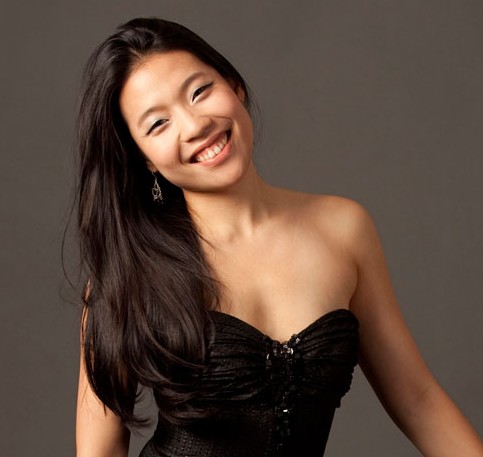- California Assembly OKs highest minimum wage in nation
- S. Korea unveils first graphic cigarette warnings
- US joins with South Korea, Japan in bid to deter North Korea
- LPGA golfer Chun In-gee finally back in action
- S. Korea won’t be top seed in final World Cup qualification round
- US men’s soccer misses 2nd straight Olympics
- US back on track in qualifying with 4-0 win over Guatemala
- High-intensity workout injuries spawn cottage industry
- CDC expands range of Zika mosquitoes into parts of Northeast
- Who knew? ‘The Walking Dead’ is helping families connect
Rebirth of ‘gukak’
Traditional music evolves into modern, hip sounds
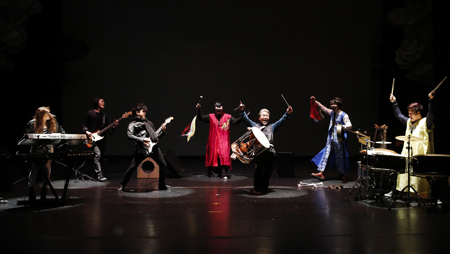
Kim Duk-soo, fifth from left, a “samulnori” master, will collaborate with indie rock musicians as part of his project “Electric Samulnori” on Feb. 14 and 21 at KT&G Sangsang Madang Live Hall in Hongdae area, Seoul.
(Courtesy of KT&G Sangsang Madang)
By Chung Ah-young
Traditional musicians often face a dilemma of whether they should only play the music of past generations or break established rules to create new styles of expression.
In recent years, traditional Korean musicians have begun experimenting audaciously to help modern audiences connect to older cultural content. They “tamper” with their instruments or crossover between traditional and Western music in efforts to popularize traditional music which is called “gukak.”
‘Piatgo’ — crossing west, east
Lim Dong-chang, a pianist and composer, invented the “piatgo,” a portmanteau made from the words piano and “gayatgo” (the old name of the “gayageum,” a traditional string instrument). The piatgo is a Korean version of the piano for playing traditional music — what he refers to as “loose melody” — by altering the hammers of the piano.
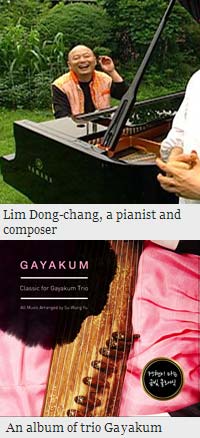 Compared to the piano, the piatgo sounds more metallic and solid. His reinvention of the instrument is to make traditional Korean music more enjoyable for the wider audience.
Compared to the piano, the piatgo sounds more metallic and solid. His reinvention of the instrument is to make traditional Korean music more enjoyable for the wider audience.
He argues that the Western world has transcended its classical music but Korea has not fully recognized the beauty of its own traditional music.
“Korean traditional music has a lofty musical integrity equivalent to Western music. Based on our musical roots with Korean sentiment, I want to play the Korean traditional music that can be shared by people around the world,” Lim said on his blog.
Lim has been invited to perform his piatgo and direct the Korean events as an art director at the grand opening of the 30th Sarajevo Winter Festival 2014, which is taking place through March 21. Along with Greece, the guest of honor, Korea is taking part in the festival as the special guest. He impressed the international audience with this instrument at the 2012 festival there.
Musical experts say that Lim’s music appeals to a global audience while keeping the essence of Korean traditional music. “The piatgo is the Koreanized Western musical instrument which was revamped to better play traditional Korean musical tunes. For classical musicians, altering the hammer of the piano cannot be imaginable but he just did it for generating more powerful sounds tailored for traditional music. It is shocking but touching,” t,a, a cultural content company, said. The company promotes Lim’s performance at the Sarajevo festival.
Electric samulnori
Kim Duk-soo, a “samulnori” master, is breaking down the barriers this time by collaborating with indie rock musicians. He will launch his project “Electric Samulnori” on Feb. 14 and 21 at the opening concert at KT&G Sangsang Madang Live Hall in Hongdae area, Seoul.
Over the last three decades, Kim has attempted to fuse various music genres with his samlunori consisting of the four traditional instruments. With his samulnori troupe, Jung Jun-suk (guitar), Lee An-na (keyboards) and Kim Jae-ho (bass) from nuTrip, an indie rock band, will join his new collaboration project. Pansori (Korean narrative song) singer Kim Na-rae will perform in English at the concert.
Based on traditional farmers’ band music, or “nongak,” Kim created the samulnori or Korean percussion music in 1978. Combining the rhythms used in nongak with musical elements from shamanist ceremonies and modern compositions, the quartets are popular not only among Koreans but also for foreigners because of the strong but harmonized beats, creating “samulnorians” worldwide.
He has performed with veteran singer Cho Yong-pil, Shin Hae-chul, DJ DOC and jazz pianist Kim Kwang-min and also released an album with a classical orchestra. But this time, he experiments with electronic music to target the international market.
“The basic culture in which spectators dance along with music in traditional samulnori is similar to the current club culture for young people. I hope our music will reach the young audience,” he said.
Kim has adapted the spirit of Korean tradition to international pop music, keeping the Korean identity but weaving out modern styles with a home-grown traditional music brand. Previously, he jammed with Red Sun, a jazz group with Austrian saxophonist, Wolfgang Puschnig, and American bassist Jamaaladeen Tacuma. They have held joint concerts in and out of Korea. Together they produced four albums since Kim’s troupe and Red Sun first met in 1987 to perform together in an international folk music festival in Europe.
Gayageum as modern version
Gayageum might be one of the most favorite instruments by fusion musicians for its wide tonal range. An increasing number of young musicians have picked up the gayageum for producing modern music in recent years.
GAYAKUM, a new trio consisting of Sohn Jee-hee, Park Ji-in and Seo Tae-kyung, has released an album carrying classical pieces performed with their gayageum. To produce the well-known Western classical repertoires including “Rondo” and “Swan Lake,” the 12-string instruments were altered to 25-string ones.
In the early 2000s, many conservative musicians thought that traditional musical instruments should play only traditional music while fusion or crossover music was ignored. But nowadays, the crossover between Korean traditional and Western music enriches the sounds with diverse instruments.
“‘Canon Variations’ has been performed by many artists in various versions. But I arranged the piece with three gayageum, which were modified for low, middle and high tones. The harmony three gayageum produce cannot be found in traditional music and this album will open a new possibility of finding the instrument,” Yu Su-wung, producer of the album, said.
“Listeners might find that traditional Korean instruments can produce such beautiful sounds that can appeal to a global audience,” he said.







